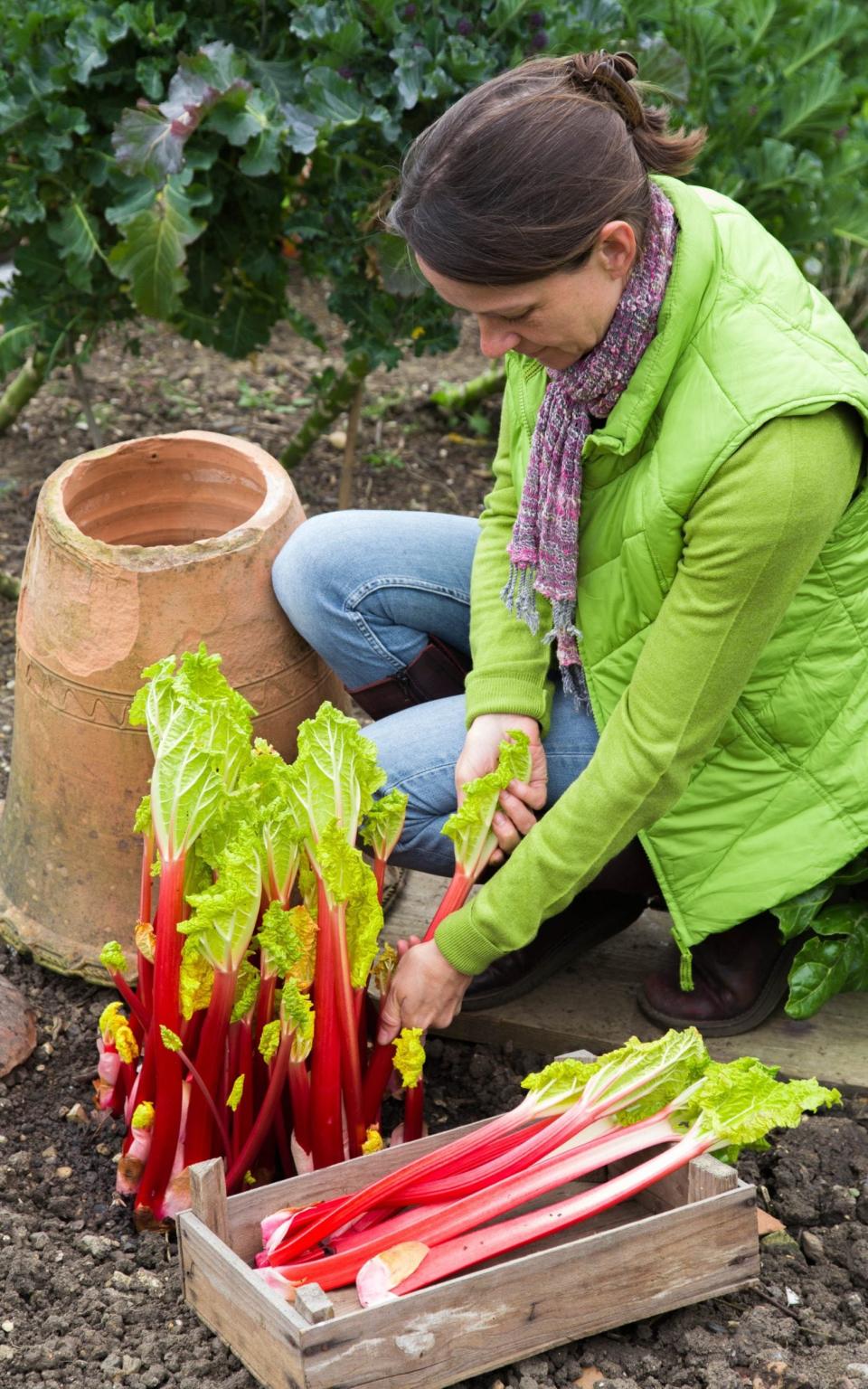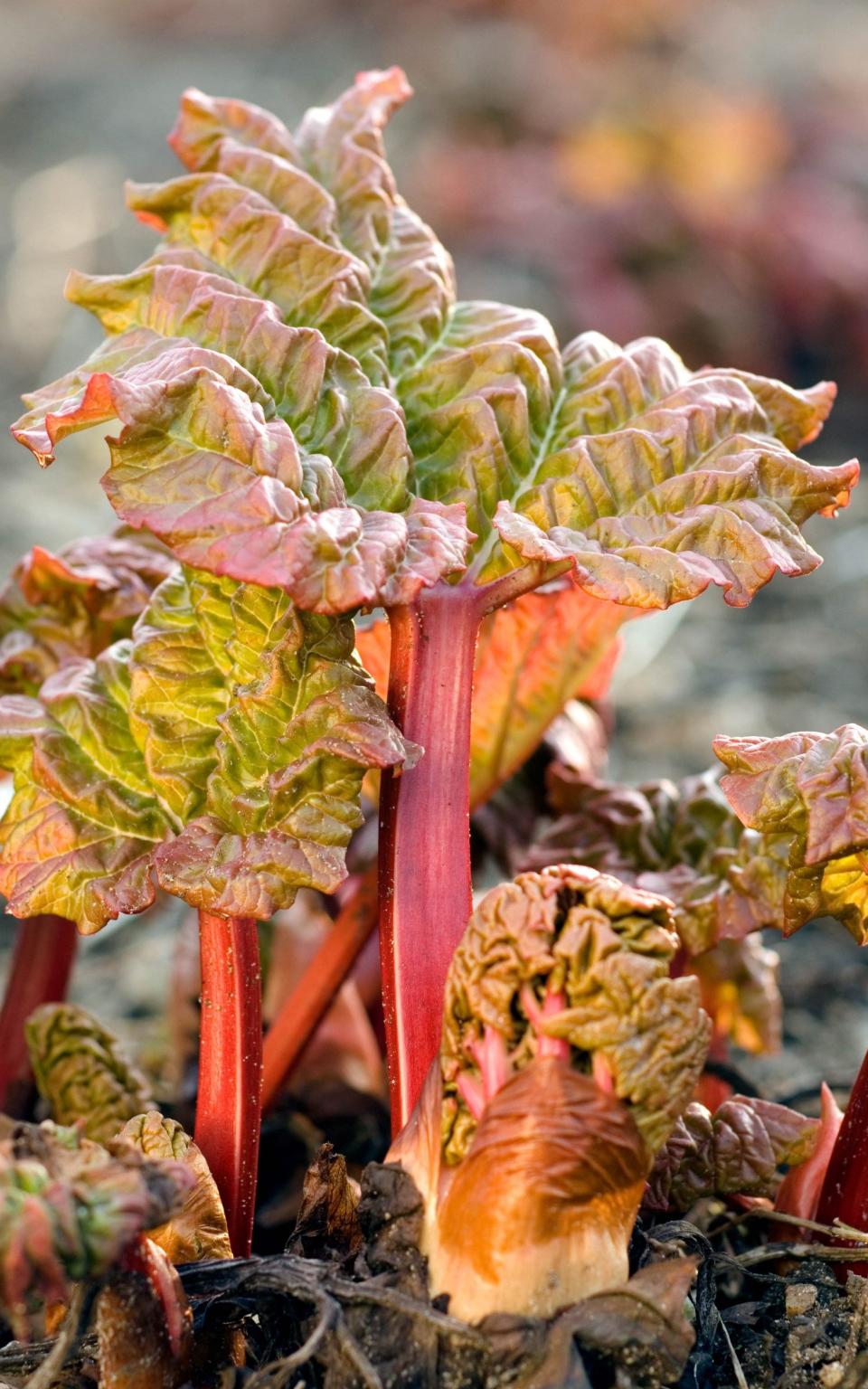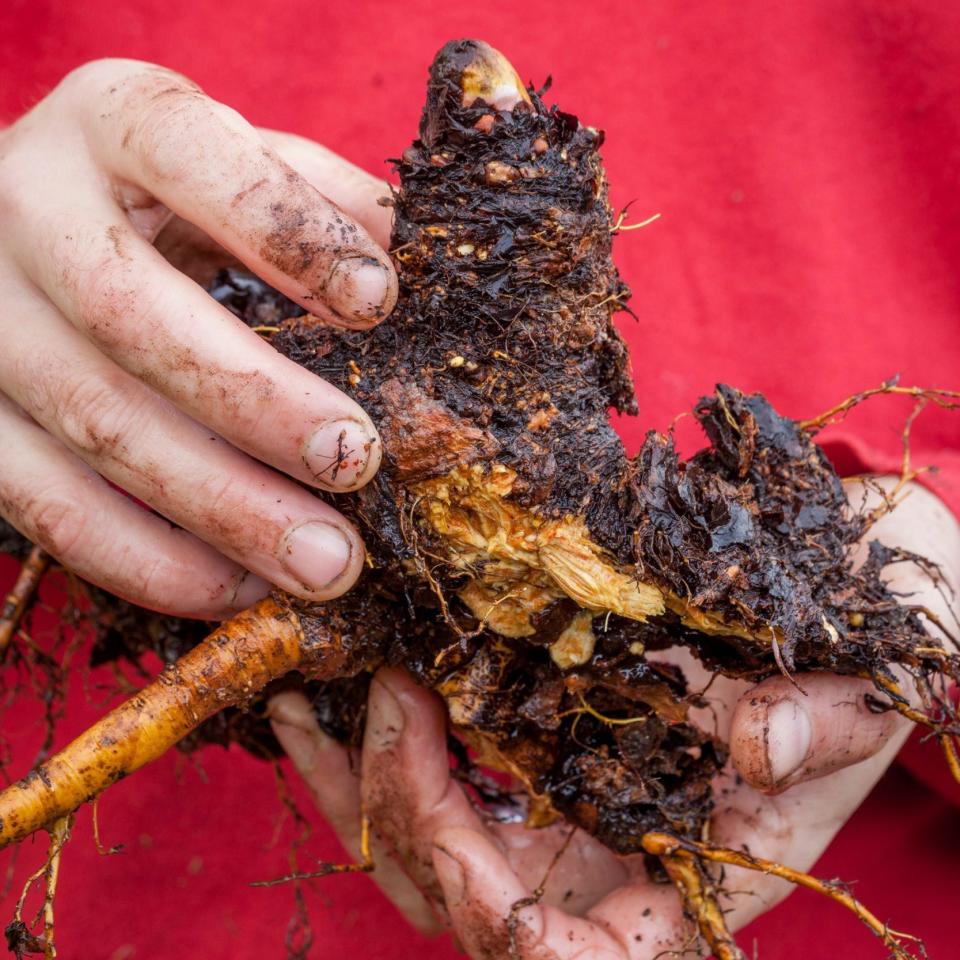How to force rhubarb successfully in your own garden

A bowl of champagne-pink rhubarb, rushed from plot to plate in less than an hour, is one of the culinary highlights of midwinter. One spoonful always spins me back in time to my early 20s.
I found myself in the dark depths of the forcing sheds in an area known as the Yorkshire Triangle. I was taking samples from the leaves and stems, because the rhubarb crop was being threatened by a number of debilitating viruses in the 1970s. Micropropagation offered a fresh solution, because heating the infected meristems eradicated the viruses and healthy plants could be used for restocking.
The cathedral-like sheds were dimly lit by candles and the silence was occasionally broken by the gentle plop of rhubarb leaves splitting their sheaths as they stirred into growth. When your eyes adjusted, you could see the forest of stems growing as the vivid-green leaves expanded upwards, like a rain forest in Gulliver’s Lilliput. The comforting warmth of the shed, although soporific for me, created perfect growing conditions for the rhubarb.
The first Yorkshire forcing shed opened in 1877 – by the 1930s, 30 square miles were being devoted to raising rhubarb and there were 200 or more producers. The true Yorkshire Triangle covered nine square miles of flat countryside east of Wakefield. The area provided cold winters, summer rainfall and deep, alluvial soil that drained easily. The secret ingredient was cheap Yorkshire coal, which kept the temperature at a constant 10C, and fuelled the engines of the Great Northern Railway. Freshly picked stems could be transported to London’s Covent Garden Market, to arrive by dawn. They fetched a premium because home-forced (also known as blanched) rhubarb was still dormant.
Only 11 rhubarb growers remain today, but their forced rhubarb is highly prized. So much so, Yorkshire forced rhubarb has made the European Commission’s Protected Food list, along with stilton cheese, champagne and parma ham.
For many years rhubarb has been widely planted by home gardeners as well. Blanching the stems, which is easily done, produces an early crop of tender stems without the acidic bite associated with mature rhubarb stems picked later in the season.

Blanched rhubarb was an accidental discovery, rather like Witloof chicory. Gardeners working at the Chelsea Physic Garden in 1817 covered some old rhubarb crowns in soil while digging trenches. When it was cleared in the early spring, they noticed tender pink stems which were delicious when gently cooked.
Rhubarb has travelled a lot further than the Chelsea Physic Garden, however. Its ancestors grew on the upper banks of the River Volga, once called the Rha. The name arose because its original home was outside the Roman Empire, in barbarian territory, hence the name rheubarbarum, shortened to rhubarb. This explains why rhubarb prefers cold winters and moist, retentive soil that drains well. Poor, dry soil and dry springs hamper growth. The Romans used the roots medicinally, to purge the system, but it has been used as a tonic and laxative by the Chinese since 2700 BC.
The Venetian explorer Marco Polo is said to have brought back rhubarb when he returned home from Asia, via the Silk Road, sometime between 1271 and 1295. The rhubarb trade became highly profitable and by 1657, the powder, made from ground rhubarb roots, was more expensive than opium or saffron. Large amounts of British money were being sent to Russia and China – where it was being used to build military might.
This worried the British government and in 1763 the London Society for the Encouragement of the Arts, Manufactures and Commerce offered a gold medal to the person who could raise the most rhubarb plants in this country. The medal was finally given to Sir William Fordyce (1724-1792), a physician who raised 300 plants. He wrote a book in 1784 entitled The Great Importance and Proper Method of Cultivating and Curing Rhubarb in Britain for Medicinal Uses.
The American president Thomas Jefferson (1743-1782) is credited with bringing edible rhubarb to American gardens. He used the leaves as spinach, but this cannot be recommended because they contain high levels of oxalic acid. Their acidic content also makes them unsuitable for compost heaps, as well as human stomachs. By 1815 the stems of rhubarb were being used in rhubarb tarts, and when the Sugar Tax was repealed in 1874, rhubarb could be eaten by all.
Rhubarb remained popular right up until the Second World War and the government fixed the price during the war so that it was within the means of ordinary people. Perhaps it was the lack of sugar, due to rationing, or maybe it was government intervention, but it became less popular after the war.
Experienced cooks will know that adding an aromatic leaf of sweet cicely (Myrrhis odorata), before you cook your rhubarb, cuts down the amount of sugar needed. Remove the leaf straight after cooking, otherwise you’ll just taste the aniseed-flavoured leaf.
Six recommended varieties of rhubarb for forcing
1. ‘Timperley Early’ AGM
If you’ve only got room for one variety, this is it. It was raised in Timperley in Cheshire before the Second World War and is widely grown commercially. The long stems have a good colour and flavour and it will also grow in a large container.
2. ‘Grandad’s Favourite’

This came from Alan Bloom’s grandfather’s garden in Cambridgeshire; the great plantsman ate a bowl every day for breakfast well into his 90s. Reliable mid-season variety with deep red stems and great flavour.
3. ‘Stockbridge Arrow’
A heavy cropping mid-season variety bred by the Ministry of Agriculture’s Experimental Station at Stockbridge House. Dark red stems and arrow-shaped leaves.
4. ‘Champagne’

Very early, tender and sweet, the pale pink stems can be pulled from forced crowns. Grown naturally, the result is still sweeter than other rhubarbs.
5. ‘Fulton’s Strawberry surprise’ AGM
Voted the best flavoured rhubarb in the RHS Wisley trials, with vivid red stems and a well-balanced acidity.
6. ‘Goliath’
Vigorous, thick-stemmed, early variety, highly rated in taste tests at RHS Harlow Carr, home to a National Collection of rhubarb.
How to grow and force rhubarb successfully

Forcing only works well with mature rhubarb plants that have been growing and storing up energy in their crowns for at least two or three years.
Order and plant bare-root crowns between autumn and spring in deeply dug soil enriched with organic material. Don’t harvest stems until plant has been in the ground for two years.
To get a yearly succession, plant three crowns, each a yard or more apart. Cover one after two or three years, then cover another the following year and so on.
Large crowns may need splitting after five years or so; do this between November and March, when the crown is dormant. Cut wedges of root with a spade, making sure there are at least three buds per division. Re-enrich the soil and ensure the top of the crown is above the ground.
When the weather begins to cool, remove any faded leaves and mulch with homemade garden compost or well-rotted manure. Cover the crown to exclude the light completely. Whichford Pottery sells terracotta forcers, with a 10-year frost protection guarantee. Upturned metal dustbins also do the job, but stuff them with some straw because metal doesn’t hold warmth on freezing nights.
The champagne-pink stems can be harvested in nine to 10 weeks, when they are about 15in long.
Harvest gently, placing your hands towards the base of the stem and pulling each one up smoothly and vertically in one movement. This will prevent the central bud from coming away. Cook carefully because soft stems disintegrate easily.
Suppliers: RV Roger (rvroger.co.uk; 01751 472226) | Brandy Carr Nurseries (brandycarrnurseries.co.uk; 01924 291511) | Thompson & Morgan (thompson-morgan.com; 0333 400 0033)
This article is kept updated with the latest advice.

